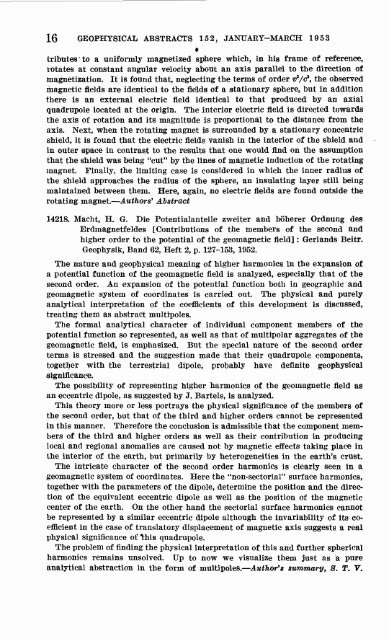Geophysical Abstracts 152 January-March 1953
Geophysical Abstracts 152 January-March 1953
Geophysical Abstracts 152 January-March 1953
You also want an ePaper? Increase the reach of your titles
YUMPU automatically turns print PDFs into web optimized ePapers that Google loves.
16 GEOPHYSICAL ABSTRACTS <strong>152</strong>, JANUARY-MARCH <strong>1953</strong><br />
t<br />
tributes to a uniformly magnetized sphere which, in his frame of reference,<br />
rotates at constant angular velocity about an axis parallel to the direction of<br />
magnetization. It is found that, neglecting the terms of order uVc2, the observed<br />
magnetic fields are identical to the fields of a stationary sphere, but in addition<br />
there is an external electric field identical to that produced by an axial<br />
quadrupole located at the origin. The interior electric field is directed towards<br />
the axis of rotation and its magnitude is proportional to the distance from the<br />
axis. Next, when the rotating magnet is surrounded by a stationary concentric<br />
shield, it is found that the electric fields vanish in the interior of the shield and<br />
in outer space in contrast to the results that one would find on the assumption<br />
that the shield was being "cut" by the lines of magnetic induction of the rotating<br />
magnet. Finally, the limiting case is considered in which the inner radius of<br />
the shield approaches the radius of the sphere, an insulating layer still being<br />
maintained between them. Here, again, no electric fields are found outside the<br />
rotating magnet. Authors' Abstract<br />
14218. Macht, H. G. Die Potentialanteile zweiter and hoherer Ordnung des<br />
Erdmagnetfeldes [Contributions of the members of the second and<br />
higher order to the potential of the geomagnetic field]: Gerlands Beitr.<br />
Geophysik, Band 62, Heft 2, p. 127-153, 1952.<br />
The nature and geophysical meaning of higher harmonics in the expansion of<br />
a potential function of the geomagnetic field is analyzed, especially that of the<br />
second order. An expansion of the potential function both in geographic and<br />
geomagnetic system of coordinates is carried out. The physical and purely<br />
analytical interpretation of the coefficients of this development is discussed,<br />
treating them as abstract multrpoles.<br />
The formal analytical character of individual component members of the<br />
potential function so represented, as well as that of multipolar aggregates of the<br />
geomagnetic field, is emphasized. But the special nature of the second order<br />
terms is stressed and the suggestion made that their quadrupole components,<br />
together with the terrestrial dipole, probably have definite geophysical<br />
significance.<br />
The possibility of representing higher harmonics of the geomagnetic field as<br />
an eccentric dipole, as suggested by J. Bartels, is analyzed.<br />
This theory more or less portrays the physical significance of the members of<br />
the second order, but that of the third and higher orders cannot be represented<br />
in this manner. Therefore the conclusion is admissible that the component mem<br />
bers of the third and higher orders as well as their contribution in producing<br />
local and regional anomalies are caused not by magnetic effects taking place in<br />
the interior of the earth, but primarily by heterogeneities in the earth's crust.<br />
The intricate character of the second order harmonics is clearly seen in a<br />
geomagnetic system of coordinates. Here the "non-sectorial" surface harmonics,<br />
together with the parameters of the dipole, determine the position and the direc<br />
tion of the equivalent eccentric dipole as well as the position of the magnetic<br />
center of the earth. On the other hand the sectorial surface harmonics cannot<br />
be represented by a similar eccentric dipole although the invariability of its co<br />
efficient in the case of translator^ displacement of magnetic axis suggests a real<br />
physical significance of this quadrupole.<br />
The problem of finding the physical interpretation of this and further spherical<br />
harmonics remains unsolved. Up to now we visualize them just as a pure<br />
analytical abstraction in the form of multipoles. Author's summary, 8. T. V.

















